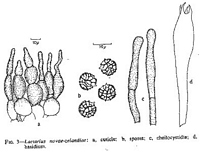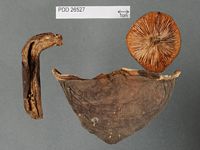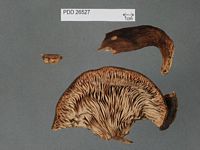|
 Lactarius novae-zelandiae Lactarius novae-zelandiae
BiostatusPresent in region - Indigenous. Endemic
Images (click to enlarge) | 
Caption: Dried type specimen
Owner: Herb PDD | 
Caption: Dried type specimen
Owner: Herb PDD |
Article: McNabb, R.F.R. (1971). The Russulaceae of New Zealand. 1. Lactarius DC ex S.F. Gray. New Zealand Journal of Botany 9(1): 46-66 (http://www.rsnz.org/publish/abstracts.php).
Description: pileus: 5.5- 13 cm diam., convex when young, applanate or centrally depressed at maturity, dry, finely pruinose to subvelutinate under lens, azonate, smooth or more frequently moderately to coarsely rugose particularly near margins, dark brown to brownish black, often with sordid salmon patches near centre; margins slightly involute at maturity, entire, often undulate. Cuticle composed of short, erect, thin-walled, hyaline, aseptate or 1-septate, filamentous to lageniform elements to 35 µm long, 6-14 µm diam., with dark brown contents in KOH, originating from inflated, short-celled hyphae often approaching the size and shape of sphaerocysts; lactiferous hyphae occasionally present. lamellae: adnate to subdecurrent, moderately crowded, thick, simple, to 9 mm deep, light orange to salmon, with dark brown edges; lamellulae present in 3 unequal series; latex viscid, white, unchanging on exposure to air, drying pallid cream. stipe: 4.5-8 cm long. ± equal, 1.3-2.8 cm diam., solid or slightly hollowed at maturity, dry, finely pruinose to subvelutinate under lens, ± concolorous with pileus, occasionally with faint yellowish-brown tints near base; flesh white at first, slowly changing through pink, salmon, and orange-red to finally vinaceous on exposure to air. Cuticle similar to that of pileus. spores: spore print ochraceous; spores broadly elliptical to subglobose, slightly obliquely apiculate, apiculus to 1.5-(2) µm long, 9-12 X 8.2-10.5 µm, ornamentation of moderately fine to coarse amyloid lamellae-like ridges to 1.5 µm high, forming an incomplete or rarely complete reticulum; plage indistinct. hymenium: basidia hyaline, subclavate to clavate, 57-70 X 10-12.5 µm, 4-spored, sterigmata to 11 µm long; pleurocystidia not seen; cheilo-cystidia numerous, filamentous, subcylindrical or cylindrical, occasionally simply branched apically, with dark brown contents in KOH, 52-68 X 6-9µm; pseudocystidia sparse, scattered, originating from lactiferous hyphae, irregularly cylindrical, not projecting beyond basidia, to 8 µm diam. hymenophoral trama: homiomerous, composed of lactiferous hyphae and closely interwoven short-celled connective hyphae, appearing cellular in section. context of pileus: white at first, slowly changing through pink, salmon, and orange-red to finally vinaceous on prolonged exposure to air, granular. smell: not distinctive. taste: lamellae mild, context slowly faintly acrid. chemical characters: formalin - pallid pinkish red: phenol - slowly deep vinaceous; FeSO4 - rapidly dull greyish green; guaiacol - faint salmon pink, turning orange-red; KOH on pileus - darkening slightly; on context - yellowing; N4OH on pileus - darkening slightly; on context - faint yellowing.
Habitat: so litary or gregarious under Nothofagus
Notes: The dark coloured, dry, pruinose to subvelutinate pileus, structure of the cuticle, and ochraceous spore print, indicate that this species belongs in sect. Plinthogali subsect. Fuliginosi, as defined by Singer (1962). Lactarius novae-zelandiae is readily distinguishable from L. sepiaceus by the light orange to salmon lamellae, changing context, and the broadly elliptical to subglobose spores with lamellae-like reticulate ornamentation.
|